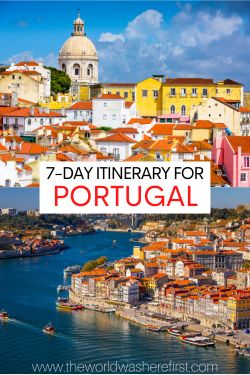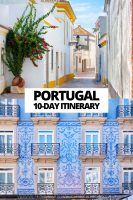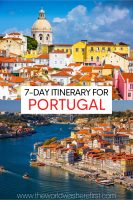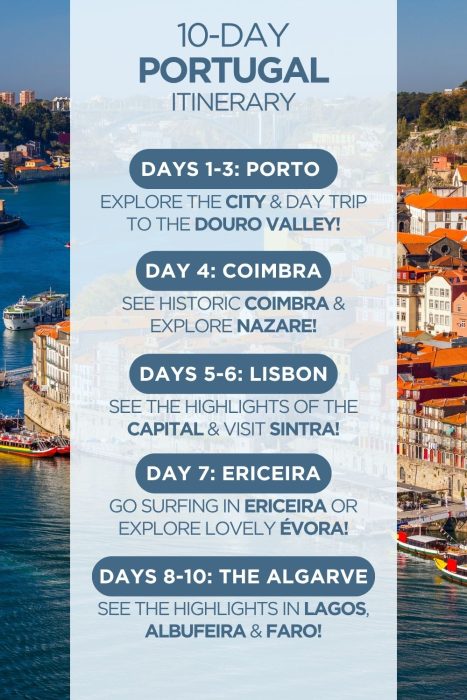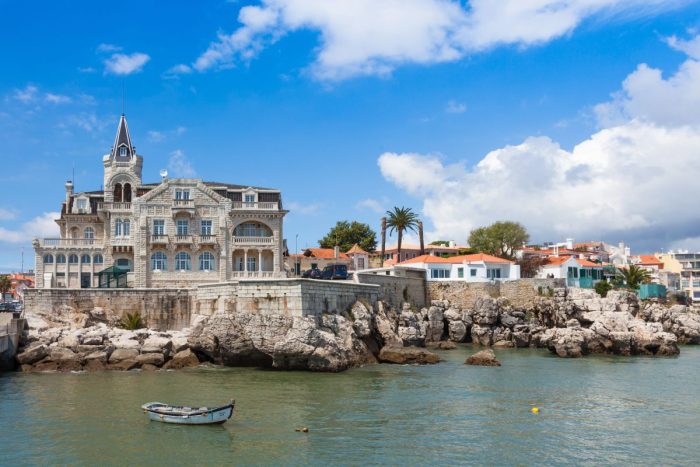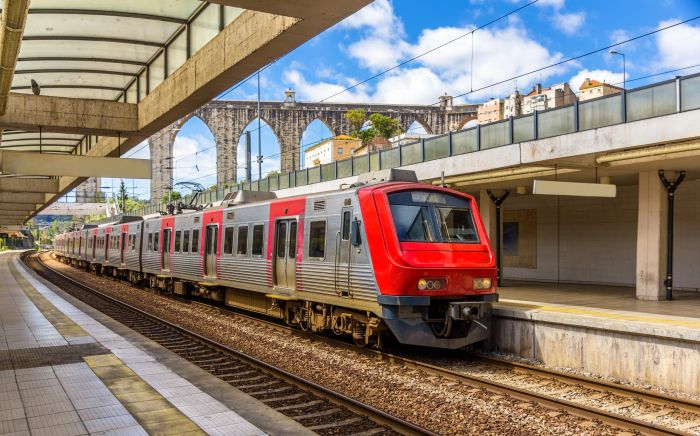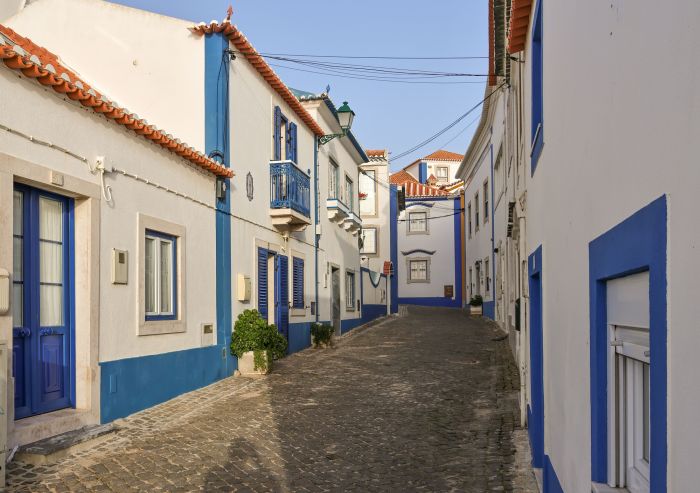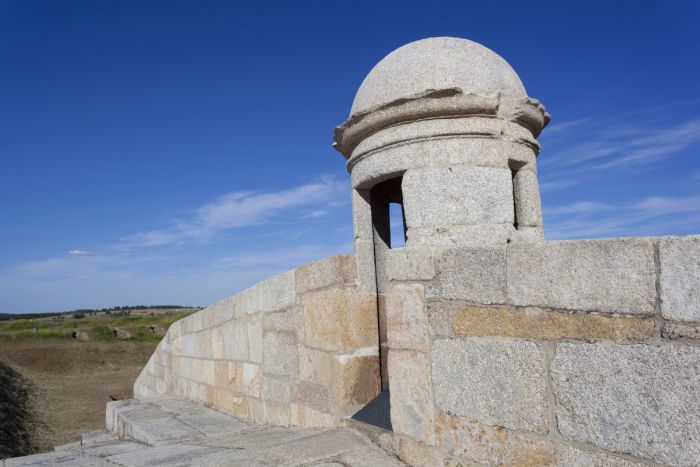Often overshadowed compared to neighbouring Spain or nearby France, mapping out a dedicated itinerary for Portugal is an excellent way to get to know this gorgeous country.
I’ve road-tripped all around the country and think that whether you’re after cool cities, world-class wine, some of Europe’s best surf spots or incredible nature, Portugal has got you covered!
Table of Contents
How Many Days in Portugal?
I suggest planning to spend at least a week exploring Portugal if you want to get a good taste of this beautiful country.
If you have 7 days in Portugal, you may not get a chance to complete the full north to south route without feeling rushed and skipping over some of the more off-the-beaten-track places but it is possible if you are pushed for time.
With one week, I recommend focusing your time on either the cities of Porto and Lisbon in the north or the Algarve region in the south. This means you get the opportunity to visit the hidden gems included in this itinerary without just bouncing from city to city.
With 10 days, you will have the opportunity to explore at a relaxed pace. By extending your stay for just a few days, you will be able to visit Porto and Lisbon, explore some historic villages and vineyards, then finish your stay in the Algarve region.
Getting To & Around Portugal
You have several options for reaching the country of Portugal. The most popular is by air and there are several airports to choose from.
For the purpose of this itinerary, I think the best option is to fly into one airport and fly out of another. Although it is possible to use the larger Lisbon airport for both directions, you will end up backtracking, which is not preferable when time is limited.
The best airport to fly into would be Porto Airport (OPO), then you would fly out of Faro Airport (FAO) in the south after completing the 10-day route. This Portugal itinerary begins in Porto so by landing here, you are saving half a day of travel from Lisbon.
When it comes to getting around Portugal, you have several options. I generally believe the best of these would be hiring a car.
By opting for your own set of wheels, you will have more freedom to explore at your own pace, stop for as many photo breaks as you like and visit the more off-the-beaten-track destinations without being beholden to limited timetables. You can view car rental options here.
Whilst the Portuguese public transport links cover most of the places included in this itinerary, there is a lot more planning involved to make sure the schedules align. During the off season, many of the more rural bus routes go down to just 3-4 services per day and may cancel altogether, which is worth considering.
There are reliable, regular trains between the main destinations of Porto, Lisbon and Faro however, so it is possible to explore without a car. It may just limit what you can achieve during your stay. You can check train schedules here.
7-10 Day Portugal Itinerary
Working our way from north to south, this itinerary begins in Porto, heads into the Douro Valley, Lisbon, Sintra and ends in the Algarve region.
Whilst this doesn’t sound like many stops for a 10-day itinerary, spending two nights in each city provides you with a base for day trips and I think gives you the opportunity to really get to know these places.
Day 1 – Porto
Many itineraries begin in Lisbon for the slightly better transport links but if you can, starting in Porto is the best choice.
We have two full days to enjoy Porto, so for your first day, I recommend exploring the hotspots before discovering some of the more hidden gems once you’ve got your bearings on day 2.
You can opt to wander the city streets on your own or take a guided walking tour.
One of the best ways to get to know a city is by joining one of these tours, led by a local guide but if you would rather head out at your own pace, Porto is easy enough to navigate and the main locations across the city are all within walking distance.
If you opt to curate your own tour, the first spot on your list should be Ribeira. This maze of cobblestone streets, colourful houses and local markets is classed as a UNESCO World Heritage Site in Porto’s historic centre. Winding its way along the banks of the Douro River, it’s one of the most picturesque areas in the city.
After exploring the old town, there are a few other gems to visit on your first afternoon before settling in to enjoy some local Portuguese cuisine at a neighbourhood restaurant.
Head over to Sé do Porto (Porto Cathedral) to enjoy the Romanesque architecture, the free viewpoint Miradouro da Vitória for incredible views across Porto and the Douro Valley and Rua Miguel Bombarda for indie shops and art galleries.
If you are interested in seeing the Azulejos, the famous blue and white tiles that are one of the country’s largest exports, there are a few must-see spots across the city. The Capela das Almas Chapel, São Bento Train Station and the nearby Igreja de Santo Ildefonso Church.
Where to Stay in Porto
House of Artists – A centrally-located mid-range hotel, they have several bright and clean rooms and a great continental breakfast available in the mornings.
In Porto Gallery Guesthouse – This high-end hotel in the centre of Porto boasts a range of spacious and stylish rooms. There is a terrace, garden and the option to include breakfast each morning.
Onefam Ribeira – A convivial hostel for travellers aged 18-39, it is located in the Ribeira district. There are a range of dorms and private rooms available for guests.
Not quite what you’re looking for? Click here to browse other Porto hotels!
Day 2 – Porto
After getting a feel for the heart of the city on day 1, it’s now time to explore a little bit deeper.
Livraria Lello is a must for book lovers, but I highly recommend getting there early to beat the crowds. There is a queue to enter from opening to closing most days, but for good reason – this book shop is crowned the most beautiful shop in the world. It is worth noting that it does cost €10 to enter, but that is refunded if you decide to purchase a book.
Take a walk along the coastline, taking in the fresh sea air to the beautiful gardens of Jardim do Passeio Alegre or visit the Serralves Museum and the large, lush green park north of the city centre.
It’s no secret that Porto is famous for its production of the fortified dessert wine called port. Specifically, the separate city that is home to the majority of port houses just across the river Vila Nova de Gaia.
It’s worth an afternoon to make the trip across to discover these houses and take a tour. Discover how this sweet drink is made and learn about the differences between ruby, tawny and various other types of port.
Aside from port, there are two dishes Porto is famous for and both happen to be variations of a sandwich. Francesinha and Bifana. Francesinha is a very rich stack of various meats, a fried egg and a spicy sauce made from beer. A Bifana is a cheaper, simpler version usually containing just pork.
Day 3 – Douro Valley
Home to hundreds of vineyards in Northern Portugal, the Douro Valley is the birthplace of port as well as several other table wine varieties.
The best way to discover the Douro Valley is on a guided tour. These usually include pick up and drop off in Porto city centre, multiple vineyard visits, tastings and a Portuguese feast for lunch.
By opting for a guided tour, you are able to properly enjoy some tastings as you don’t have any driving to worry about. If you have hired a car for this trip, you could opt to go on a self-guided tour, but bear in mind that means the driver won’t be able to sample any alcoholic drinks.
This is your last night in Porto before heading down towards Lisbon, so make the most of the Petiscos (Portuguese tapas) and enjoy some live Fado (soulful Portuguese traditional music) before heading back to your accommodation.
Day 4 – Coimbra & Nazare
Day 4 we are heading off on a road trip. There are two key destinations to visit as we head south and end the day in Lisbon.
If you don’t have a car, you can join a guided transfer between Porto & Lisbon that stops in Coimbra or take a guided tour from Porto & then make your own way to Lisbon.
First is the inland city of Coimbra, the medieval capital of Portugal. Just an hour away from Porto, nestled along the Mondego River, this ancient city is famed for its prestigious University of Coimbra, one of the oldest in Europe.
This university is a UNESCO World Heritage Site, containing several must-see sites such as the baroque Joanina Library and the Royal Palace.
After visiting the university, head down through the city’s cobbled streets from Alta to Baixa. Admire Arco de Almedina, the medieval city gate, visit the artisan boutiques, cafes and restaurants along Rua Ferreira Borges with a stop at Santa Cruz Church, where Portugal’s first king is buried.
Another hour south, along the dramatic Portuguese coastline, you will come across the famous town of Nazare. If you’re not into surfing, you may not have heard of it, but it is well worth a visit regardless.
Here you will find some of the largest waves in the world due to a large offshore canyon that refracts and focuses swells. The world record for the largest wave ever surfed took place here by Sebastian Steudtner, a professional surfer.
Whilst the waves may not be accessible to you and me, just witnessing these gigantic waves crashing along the coast makes Nazare worth a stop. Visit the Fort of São Miguel Arcanjo & Lighthouse perched high on the cliff for incredible views along the shore.
We will be based out of Lisbon for the next four nights, which is just another 1.5 hours south of Nazare.
Where to Stay in Lisbon
Alegria A Lisbon Boutique Hotel – A comfortable hotel centrally located on Alegria Square, there are a range of twin, double and king rooms available along with a suite. There is also a restaurant and breakfast.
Lisboa Carmo Hotel – An elegant hotel in the heart of the city, there are several opulent rooms, an airport shuttle, an on-site bar and a very good breakfast each morning.
Home Lisbon Hostel – This highly-rated hostel not only has a great location and a range of dorms and private rooms, they also offer breakfast and organise social events.
Not quite what you’re looking for? Click here to browse more Lisbon hotels!
Day 5 – Lisbon
Spread across seven hills overlooking the Tagus River, Portugal’s vibrant capital is Europe’s sunniest capital, and dedicating a full day to exploring just the city itself is a must.
You will also be spending the next couple of nights here, so you will have plenty of evenings to wine and dine, listen to live fado music and eat as many pasteis de nata as you possibly can.
The best way to start your day in Lisbon is in the city’s oldest districts, Alfama and Baixa either independently or on a historical walking tour.
Head up to a viewpoint in the early hours to catch the sunrise over the city, Miradouro da Senhora do Monte provides the best views over the castle, river and red tiled roofs, but be prepared to walk uphill to reach it.
If you don’t want to walk all the way up to the top, Miradouro da Graça is around halfway up but also provides incredible city views.
Whilst it’s still early in the day, it’s the perfect time to ride on the iconic yellow 38 tram. During the peak summer months, there can be long queues so hopping on early to explore the historic district is the best way to avoid the crowds.
You can’t miss wandering the São Jorge Castle walls and gardens whilst in the area and visit the many peacocks that roam the grounds.
After riding the tram, it’s also worth wandering the streets of Alfama on foot. Make sure to pack comfortable footwear for exploring Lisbon; it is hilly and combined with the cobblestones, it can take a toll on your feet if you’re not prepared.
In the afternoon, head over to the Belém district. It’s a 20-minute tram ride or taxi away (you can also go on a bike tour) from Lisbon but I think it’s worth making the short trip. Belém used to be a separate city until Lisbon expanded and encompassed it.
Next is the monastery and church Belém is famous for, Jerónimos Monastery and Igreja de Santa Maria de Belém. This monastery was also allegedly the birthplace of the famous Portuguese sweet treat, the Pastel de Nata.
They sold the recipe to the local bakery next door, Pastéis de Belém who claim to still be using the original recipe. It is well worth standing in line to try one from this bakery before heading back into the city.
Spend the evening wandering through the streets of Chiado, full of shops, cafes, and A Brasileira (famous for Fernando Pessoa’s statue), before heading up onto one of the hills to find a viewpoint such as Miradouro de Santa Catarina or São Pedro de Alcântara for sunset.
Day 6 – Cascais & Sintra
There are several options for day trips from Lisbon and many can be combined into one such as this guided tour if you are an early riser and want to make the most of the day.
For the purpose of this itinerary, I have combined Cascais and Sintra into one day, and given you the option of Ericeira or Évora for day 7.
Cascais is a very picturesque seaside town, around 40 minutes north of Lisbon. The easiest and cheapest way to reach it is on the green metro line from Lisbon. Make sure you sit on the left side (south facing) when you depart Lisbon for some of the best views of the Portuguese Riviera
Once a quiet fishing village, it has grown into one of the country’s most charming and affluent seaside destinations.
Take your time to explore the cobblestone streets lined with boutique shops, enjoy fresh seafood at local restaurants, or relax along the scenic coastline.
Moving on to Sintra, a fairytale mountain town tucked away inland. A short 30-minute drive from Cascais or if you are relying on public transport, there is a direct bus available.
Famed for its grand palaces, lush forests, and misty hillsides, Sintra is a UNESCO World Heritage Site. The town was once a royal retreat, and you can visit sites like the Palácio da Pena, the Quinta da Regaleira, and the Palácio Nacional de Sintra.
There are also plenty of hiking opportunities in the natural park nearby, waterfalls, forests and rolling hills so you can really make the most of your afternoon before heading back to Lisbon.
Day 7 – Ericeira or Évora
It’s day 7 of your trip to Portugal and today you have a choice to make – Ericeira or Évora?
If you have ever dipped your toe into the world of surfing, it’s likely you may already have heard of Ericeira. A laid-back surf town northwest of Lisbon, Ericeira has earned global recognition as Europe’s only World Surfing Reserve.
The town itself is a traditional fishing village with lovely cobblestone streets, whitewashed houses with blue trim mixed with modern surf culture. Beyond surfing, Ericeira has some beautiful beaches like Ribeira d’Ilhas and Foz do Lizandro, perfect for spending the day relaxing, as well as excellent seafood restaurants and local cafes.
Évora, on the other hand, is an inland town. Designated a UNESCO World Heritage Site, Évora boasts sites like the Roman Temple of Évora, the Gothic Cathedral of Évora, and the eerie Chapel of Bones.
It also has gorgeous whitewashed houses, narrow winding streets, and ancient city walls.
Both towns are worth spending an entire day exploring, so choose whichever appeals to you most – or simply spend another day exploring Lisbon!
If you only have one week when you visit Portugal, this marks the end of your stay. Lisbon is home to a large international airport, making it the perfect place to either fly home or continue your adventure.
Day 8 – Lagos
For the last few days of this itinerary, we will be heading south to visit the sun-soaked Algarve region.
Lagos once served as a key port during the Age of Discoveries. Today, it is home to cobbled streets, lively markets, and a bustling marina lined with bars and restaurants. The town’s landmarks include the 17th-century Forte da Ponta da Bandeira, the Church of St. Anthony, and remnants of ancient city walls.
Starting early, the best way to spend your morning in Lagos is by joining a boat tour to explore the sea caves and grottoes at Ponta da Piedade. The earlier slots tend to be quieter and you will avoid the hot midday sun.
Returning to Lagos, take your time to wander through the city streets, discovering the medieval buildings, churches and local markets in the historic centre.
While away the afternoon on the Praia do Camilo beach, known for its golden sand, turquoise waters, and dramatic limestone cliffs. And if you want to sample some excellent local seafood, I can recommend eating at Restaurante Camilo nearby.
These next 3 days will be spent exploring the Algarve region along the south coast. You can opt to either spend one night in each location or discover a more central accommodation near to Albufeira where you can spend the next 3 evenings if you’d rather unpack and settle into just one location.
Where to Stay in the Algarve
Lagos Avenida Hotel – Located in Lagos, this seaside hotel has a range of twin and double rooms available (with either city or marina views), private parking, a swimming pool and an airport shuttle.
3HB Faro – A lovely luxe hotel in cool Faro, this place boasts 2 outdoor swimming pools, an on-site spa and wellness centre, a great location for exploring the area and a superb buffet breakfast.
Pine Tree Apartments – Located in Albufeira, these apartments are great for a self-catering option. They offer studios, one- and two-bedroom options and there is also an on-site swimming pool.
Casa da Madalena Backpackers Hostel – This cool hostel located in the historic centre of Faro is an excellent budget choice. There is free breakfast, 24-hour reception and a great social atmosphere.
Not quite what you’re looking for? Click here to browse more Algarve hotels!
Day 9 – Albufeira
Another former fishing village, Albufeira is now a bustling town known for its beautiful beaches, vibrant nightlife and boat tours to the Benagil Sea Caves.
You can’t spend a day in Albufeira without hopping on a boat to visit one of Portugal’s most famous landmarks, the Benagil Sea Caves.
The main cave features a large domed ceiling with a circular skylight, allowing sunlight to pour in, creating a sea grotto. You often spot dolphins leaping out of the Mediterranean Sea en route to the caves, too.
The historic Old Town of Albufeira has a traditional Portuguese atmosphere, with narrow cobbled streets, whitewashed houses, quaint shops, and a wide selection of restaurants serving local seafood and traditional Portuguese dishes.
It’s perfect for a relaxing afternoon stroll or a quiet meal by the sea. If you’re keen to enjoy the sunshine and sand, head to the Praia dos Pescadores or Praia da Oura beaches nearby.
In contrast, the ‘strip’ in the Montechoro area buzzes with energy, coming alive at night, with bars, clubs, and live entertainment. If you do plan to stay in Albuefeira, I recommend you make sure your accommodation is tucked away from the ‘strip’ to ensure a quiet evening’s rest.
Day 10 – Faro
With fewer crowds than other Algarve destinations like, Faro offers a more laid-back experience compared to Lagos or Albufeira.
Enclosed by ancient city walls, Faro’s Old Town (Cidade Velha) is filled with cobbled streets, charming squares, and landmarks such as the Arco da Vila and the beautiful Faro Cathedral.
The city also features the intriguing Igreja do Carmo, famous for its Chapel of Bones, and a lively marina surrounded by cafes and shops.
If you are a nature lover, Faro also acts as the gateway to the Ria Formosa Natural Park – a network of tiny islands and deserted beaches.
This is the perfect place to round up this Portugal itinerary as it’s home to Faro airport (often referred to as the Algarve airport).
Have More Time?
If you are a city-hopping enthusiast, you may want to spend more time in the Algarve cities. You could easily spend 2-3 days in each town or city if you had time to spare.
Alternatively, for the adventurous travellers, consider continuing your road trip up into the mountainous region on the border between Portugal and Spain.
There are several less touristy, rugged mountain towns and villages home to castles, sprawling forests, gorges and waterfalls to discover in this lesser-known region.
Consider adding the villages of Monsanto, Sortelha and Almeida to your itinerary.
If you are on the lookout for the best nature spots for hiking, make sure to visit the wild landscapes and waterfalls of the Peneda-Gerês National Park, the Arouca Geopark, home to the Paiva walkway and Serra da Estrela Natural Park, home to Portugal’s tallest mountains and glacial valleys.
Spending 7-10 days exploring the country of Portugal is a real joy. This varied country is full of surprises, and it’s no surprise you’ll be planning your next Portuguese adventure in no time.
Do you want to visit Portugal? Have any questions about this itinerary? Let us know in the comments!
